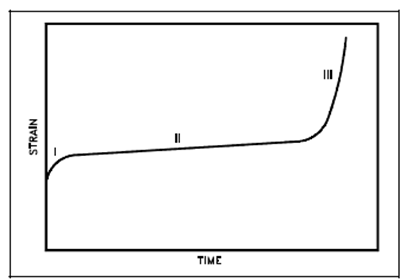Creep:
While room temperature, structural materials establish the full strain they will exhibit as soon as a load is applied. That is not necessarily the case at high temperatures (for example, stainless steel above 1000º F or zircaloy above 500º F). At elevated temperatures and constant stress or load, several materials continue to deform at a slow rate. That behavior is known as creep. At a constant stress and temperature, the rate of creep is around constant for a long period of time. After this period of time and after a contain amount of deformation, a rate of creep increases, and fracture soon follows. This is described in below figure.
Primarily, main or transient creep occurs in Stage I. A creep rate, (the slope of the curve) is high at first, but it quickly decreases. This is followed through secondary (or steady-state) creep in Stage II, While the creep rate is small and the strain increases extremely slowly along with time. Finally, in Stage III (tertiary or accelerating creep), the creep rate increases more quickly and the strain might become so large which it results in failure.

Figure: Successive Stages of Creep with Increasing Time
The rate of creep is highly dependent on stress and temperature both. Along With most of the engineering alloys used in construction at room temperature or lower, creep strain is so little at working loads in which it could safely be ignored. It does not become important until the stress intensity is approaching the fracture failure strength. Therefore, as temperature increase creep becomes progressively more significant and eventually supersedes fatigue as the likely criterion for failure. A temperature at that creep becomes important will vary along with the material.